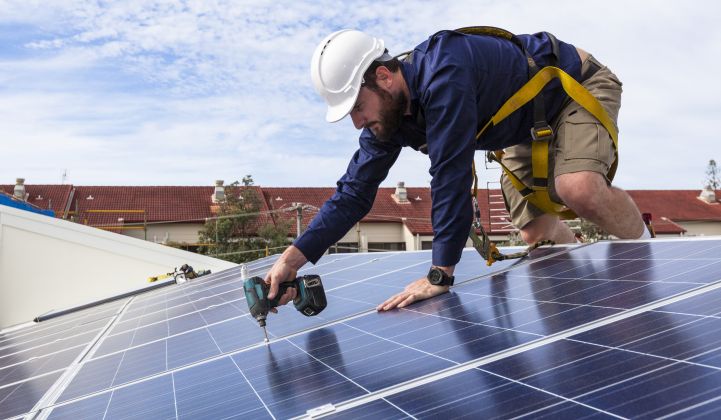Solar topped natural gas and wind to claim a record share of new U.S. electric generating capacity last year, at nearly 40 percent of the market, boosted by a vibrant residential sector that looks healthier than it has in years — at least before COVID-19 hit.
2019 was a landmark year for the American power sector on several fronts. Wind crossed the 100-gigawatt threshold, and it overtook hydroelectric plants in total electricity generated. But solar stole the show, with four out of every 10 megawatts of capacity built last year represented by a PV panel.
All told, the country added 13.3 gigawatts of new solar last year, bringing the cumulative total to 76 gigawatts, according to the U.S. Solar Market Insight report, published quarterly by the Solar Energy Industries Association and Wood Mackenzie Power & Renewables.
Solar accounted for 39.8 percent of new U.S. generating capacity brought online last year, blowing past natural gas at 32 percent and wind at 27 percent. It’s just the second time that solar was the leading source of new capacity, and the first since 2016.
It’s hard to ignore the booming utility-scale market, which accounted for 8.4 gigawatts of last year's solar additions — and where the contracted pipeline of projects now stands at a record 48.1 gigawatts. The large-scale market is underpinned by the proliferation of state renewables mandates, rising corporate demand and costs that continue to drop in spite of the Trump administration’s solar import tariffs.
Solar power-purchase agreements ranged from $16 to $35 per megawatt-hour last year, the report said, spurring demand in existing hot spots like Texas as well as states where little solar has been procured in the past, such as Oklahoma and Pennsylvania.
Revived residential market
Arguably the most exciting market segment, however, was the one centered on people’s homes. Residential solar installations have now fully recovered from the market contraction of a few years back — when a swooning SolarCity was acquired by Tesla — with a record 2.8 gigawatts added in 2019.
California became the first state to add more than 300 megawatts of residential solar in a single quarter during Q4, and the Golden State added more than 1 gigawatt over the course of the year for the third time. And that's before the state's new-build home solar mandate went into effect this year.
California’s perpetual solar overperformance aside, much else looks different in the jobs-rich residential market compared to the pre-2017 days — notably the rise of states like Florida where project economics, rather than incentives, serve as the key driver of demand.
Austin Perea, senior solar analyst at WoodMac, said Florida represents a “window into the future of the national residential solar market," given the state's lack of special incentives for home solar systems and its modest electricity prices.
Texas-based Sunnova launched the American solar industry's first major initial public offering in years in 2019, with plans to add as many as 30,000 new customers in 2020. National residential leader Sunrun deployed record solar capacity in Q4. SunPower, meanwhile, has split from its manufacturing division to focus on delivering high-end distributed solar and storage systems.
Beyond simple dollars and cents, the residential market is benefiting from a variety of new tailwinds, including growing concerns about climate change and blackouts in the wake of California’s devastating wildfires last year.
Those same factors are also fueling the residential energy storage market, which many home solar installation companies have embraced to grow their business.
Impact of COVID-19: TBD
WoodMac and SEIA predicted huge growth for the 2020 market, with installations expected to surge 47 percent to around 20 gigawatts — which would blow the current record year of 2016 out of the water. However, that outlook was made before the impact of the COVID-19 outbreak cast a pall over the global economic picture, including renewable energy markets.
“We know anecdotally that the COVID-19 pandemic is starting to impact delivery schedules and that it could affect demand for solar as well as our ability to meet project completion deadlines based partly on new labor shortages," SEIA CEO Abigail Ross Hopper said in a statement.
"This once again is testing our industry’s resilience, but we believe, over the long run, we are well positioned to outcompete incumbent generators in the Solar+ Decade and to continue growing our market share," she said.
***
Download the free executive summary of the U.S. Solar Market Insight report here.




